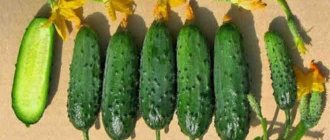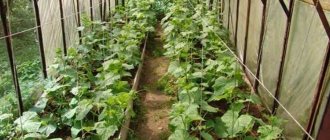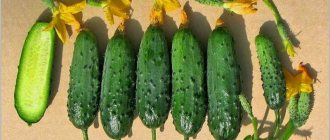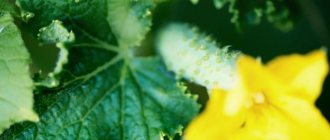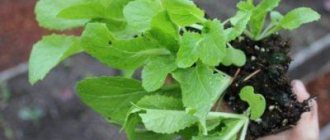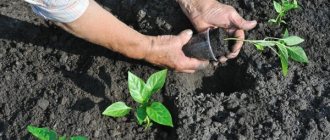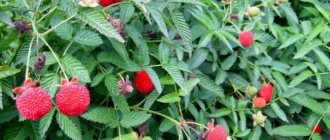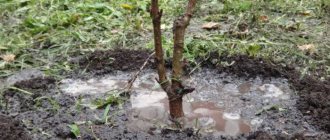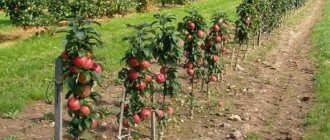History of variety development
The Bettina F1 cucumber was bred by Dutch breeders at the beginning of this century (in 2007) and almost immediately it attracted the attention of vegetable growers from around the world, including Russia. As a result, this cucumber hybrid underwent variety testing in Russia, and in 2010 it was included in the Russian State Register. At the same time, Bettina F1 cucumber was recommended for cultivation in most Russian regions.
Important to know:
What are F1 and GMO hybrid seeds
Reviews from summer residents
Natalya from Kursk. I have been growing cucumbers on my plot for 3 years in a row. For this I use a film greenhouse. There is not much work to do with it: let the whip fall on the support and calmly wait for the harvest. I use organic matter as a fertilizer (infusion of cow dung and grass). The fruits ripen very early - after 35-40 days. I harvest before the cold weather. For the most part, I put gherkins in jars for the winter. We eat the rest fresh.
Valentina from the Moscow region. I grow early vegetables under film. I saw the presented cucumber last year in a photo of one of the agricultural sites. I studied the description and then decided to order the seeds. The seedlings were powerful, larger than others. The cucumber grew quickly and soon produced a high-quality harvest. The taste of gherkins is delicate and crispy.
Bettina is a hybrid cucumber that will delight you with an early harvest. Compliance with simple rules of agricultural technology guarantees the production of tasty greens under any conditions.
Description
This hybrid is early ripening - almost 1.5 months pass from the moment the seed material germinates until the first greens are harvested. This cucumber is classified as an indeterminate type; its cucumber vines are not limited in growth. Side shoots are formed in limited quantities.
The Bettina cucumber is a parthenocarpic type, so only female flowers appear on the vines. And most fruits are set only on the central stem.
The bushes of this hybrid should not be formed, since its vegetative stepsons stop growing at a height of 1.5 m, and subsequently fruits are set on developing stepsons. Therefore, there is no need to delete them. The cucumber vines are well leafy, the foliage is of medium size, slightly wrinkled, dark green in color.
Related article:
Why crooked cucumbers grow: possible reasons, solutions to the problem and recommendations
Due to the fact that this variety is early ripening, it can be grown twice per season, and grown in heated greenhouses all year round.
This variety is characterized by a bunched type of ovary formation. in this case, from 1 to 4 cucumbers can form in each leaf axil.
Ripe cucumbers of this variety are cylindrical in shape and small in size. Their length can be up to 10 cm, and their weight is about 70-80 g.
The best varieties of cucumbers for the greenhouse
The surface of the fruit is leveled and homogeneous. The skin is of medium thickness, dark emerald in color, with small light stripes. All over the surface of the green grass there are small tubercles with brown thorns. Pubescence is of medium density.
The pulp is tender and quite juicy; there is no bitterness in it at the genetic level. There are no voids in the gherkins, and they do not appear even during heat treatment.
Related article:
Cucumbers - the secrets of “hand” pollination
You can harvest at the gherkins and pickles stage. Moreover, the more often ripe greens are collected, the more new ovaries are formed. The harvested crop can be transported to any distance, without deteriorating the appearance and taste of the gherkins.
What do summer residents say about Bettina cucumbers?
After reading reviews from vegetable growers, it turns out that we can form a more complete understanding of the variety. The information that is reflected in them allows you to avoid mistakes when growing.
- Natalya Nikolaevna: “I really like Bettina F1 cucumbers. We managed to grow a rich harvest on the first try. Since then I have been growing this variety for 5 years. I have never disappointed, there is always a harvest. I think the main advantage is early maturation. It is demanding when it comes to watering and loves fertilizing with nitrogen and potassium.”
- User: “What attracts me most is the undemanding nature of the bush and its compactness. High yield and the earliest ripening period among gherkin varieties.”
Bettina is a hybrid that is immune to diseases. Suitable for gherkin lovers.
Bettina is an early-ripening gherkin-type cucumber hybrid, obtained by employees of the Dutch branch of the breeding and seed company Nunhems BV in 2007. Designed for cultivation in open ground (it is advisable to cover it with film in the first stages of the growing season) in private garden plots. It is also successfully grown by indoor gardeners on windowsills. In 2010, the variety was included in the state register of breeding achievements of the Russian Federation in all regions.
The variety is parthenocarpic (does not require pollination by bees), of a generative type - it forms the bulk of the harvest on the central stem. Suitable for the first and second rotation, and can also be used in winter-spring rotation for early cultivation in film greenhouses. The period from germination to the beginning of fruiting is 38 - 42 days.
The plants are indeterminate, compact, of medium vigor, medium branched, with exclusively female flowers. The leaves have a dark green color and a medium leaf blade size. Recommended planting density is 2.8 - 3.5 plants/sq. meter.
Formation of bushes is practically not required. This is due to the fact that at a height of 1 - 1.5 meters from the ground, vegetative stepchildren stop growing, and above that only generative stepchildren grow, on which fruits are formed - they do not need to be removed. Bettina cucumber responds well to increased doses of nitrogen and potassium fertilizers and requires abundant watering.
Cucumbers are smooth and uniform, cylindrical in shape, with large tubercles, short, weighing 60 - 80 grams. The skin is dark green, with short white stripes. Pubescence of medium density. The spines are brown. Pulp without bitterness, without voids. In open ground, the yield of marketable fruits is 5 kg/sq.m. The plant produces most of its harvest in the first month of fruiting.
Main characteristics of the variety
This hybrid is unpretentious to growing conditions and does not require special care, so even novice summer residents can grow it.
Cucumber Bettina F1
Productivity
The variety is distinguished by excellent productivity - at least 5 kg of ripe gherkins can be harvested from each square of area. In addition, this hybrid is distinguished by the friendly ripening of fruits, most of which ripen within 25-30 days from the beginning of fruiting.
Area of application of fruits
Ripe gherkins and pickles are intended for fresh consumption, pickling and canning. Moreover, during heat treatment, voids do not appear inside the cucumbers, and the taste remains the same.
Related article:
Making a honey solution for feeding cucumbers
Cross-section of Bettina F1 cucumber
Diseases and pests
Like all cucumber hybrids of Dutch selection, this cucumber has high resistance to most diseases characteristic of other varieties of this vegetable crop, including powdery mildew, cladosporiosis, common mosaic virus, and downy mildew.
Important! Why do cucumber leaves turn yellow: 6 main reasons
Diseases and pests
"Bettina f1" is resistant to common diseases, but preventive measures will help further reduce the likelihood of diseases occurring. Early ripening varieties are not treated with chemicals, as toxic substances can be deposited in early greens. Therefore, folk remedies are used to treat early ripening varieties:
- to prevent powdery mildew, plants are sprayed with 20 g of laundry soap without fragrances and dyes, 9 liters of warm water, 1 liter of skim milk, 30 drops of iodine;
- for gray rot, water the bushes at the root with water and baking soda (75 g of soda per bucket of water);
- for bacteriosis, use trichopolum (2 tablets per 1 liter of water).
Many pests will be repelled by garlic and onions planted between rows of cucumbers. To protect the plantings from spider mites and slugs, the bed must be dug up in the fall so that the soil freezes.
The main advantages of the variety
The main advantages of the cucumber hybrid Bettina F1 include:
- high productivity;
- unpretentiousness to growing conditions;
- It does not require special care;
- resistant to stressful weather conditions, sudden drops in temperature, lack of lighting;
- ripe fruits can be picked not only at the gherkin stage, but also at the pickle stage;
- the harvested crop can easily withstand transportation over any distance and has a long shelf life;
- resistant to most diseases that affect other varieties of cucumbers.
Related article:
Cucumber Hector F1 – description and characteristics of a super early variety, reviews
Advantages and disadvantages
Positive qualities of a hybrid:
- quick yield of the crop;
- ease of care;
- disease resistance;
- growth under unfavorable conditions, in shaded areas;
- high productivity;
- the versatility of vegetables in cooking;
- long fruiting;
- excellent taste;
- good presentation;
- transportability over long distances without loss of presentation or taste.
Flaws:
- high cost of seeds;
- the impossibility of collecting grains from one’s own harvest for further sowing.
Features of planting and care
Any cucumber hybrids are unpretentious to growing conditions; they also do not need special care - they practically do not get sick and bear fruit even in unfavorable weather conditions.
Typically, cucumbers of this variety are grown in open ground, but they are successfully grown in regions with unfavorable climatic conditions in film greenhouses and greenhouses.
To get really early production, you should grow the Bettina F1 hybrid in seedlings. To protect it from returning spring frosts, it is planted in garden beds no earlier than the first ten days of May. Therefore, seedlings are planted in the first half of April.
Related article:
Secrets of late sowing of cucumbers
And in regions with an unpredictable climate (Siberia, the Urals), cucumbers begin to be grown in open ground no earlier than the end of May - beginning of June, so seedlings are planted in the last ten days of April.
In order for cucumbers in garden beds to grow and bear fruit well, it is necessary to select the right area for growing them and prepare it correctly.
Cucumbers need a well-lit area with light, fertile soil. Therefore, during the autumn digging, humus or rotted compost is added to the soil, and in the spring mineral fertilizers are added to the holes. In open ground, cucumber seedlings are planted as follows: no more than 4 cucumber bushes should be placed on each square of area. And it doesn’t matter if the cucumber vines grow greatly during growth and begin to block each other’s light - this cucumber hybrid grows well and bears fruit in light partial shade.
Related article:
Cucumber Izobilny F1 - description and characteristics of a high-yielding hybrid
Therefore, the bushes of the Bettina F1 hybrid do not need to be formed and the lateral stepsons on which fruiting will occur need to be removed.
Of the top dressings, this vegetable crop is most susceptible to organic fertilizers. Therefore, most often, cow manure diluted with water (in a ratio of 1:10), horse manure (in a ratio of 1:10) or chicken manure, which must be diluted with water in a ratio of 1:20, is added to cucumber beds. You can also add an infusion of wood ash, which contains a large amount of macro and microelements, to the beds where cucumbers of this variety grow.
You should also apply complex mineral fertilizer with a high phosphorus content to cucumbers of this variety at least once a season. In the process of caring for this cucumber crop, the following agrotechnical measures should be carried out:
- in the evening hours, watering with water heated in the sun is carried out strictly at the root, so that drops of water do not fall on the foliage;
- Once every 6-8 days, cucumber vines are fed with the fertilizers described above;
- After each watering or rain, you need to loosen the root zone of the cucumber vines in order to break up the dry crust that forms on the surface of the earth. This operation must be carried out carefully so as not to damage the root system of plants located close to the soil surface. At the same time, you need to remove all weeds in which harmful insects may be hiding.
Related article:
Kotor f1 - a cucumber variety with high yield
Productivity and positive traits of the variety
Cucumbers can be harvested already after 40 days. A good scheme is to collect greens every 3 days. Product yield can reach 5 kg per m2. Basically, productivity depends on the quality of care and the creation of maximum favorable conditions for the growth and development of this plant crop.
Bettina has many positive characteristics. The advantages of the hybrid variety are as follows:
- Cucumbers can easily tolerate unexpected drops in temperature. Other varietal species stop growing and developing under such conditions.
- Lack of lighting does not affect the amount of harvest.
- The plant almost does not form stepsons, which does not require a lot of time spent on care.
- Zelentsy ripen early. In one season, the plant can actually be grown twice.
- The yield indicators cannot be called high, but they are sufficient for the early period. Up to 5 kilos are collected from a bush.
It is universal in use. Cucumbers are prepared as gherkins, consumed in salad dishes and on their own. Vegetable growers cite the high price of seed as a disadvantage. Since Bettina is a hybrid, collecting seeds yourself is impossible.
Hybrid cucumber "Bettina F1": photo, video, description, planting, characteristics, yield, reviews
Cucumbers are grown for industrial processing, as well as in vegetable gardens, cottages and personal plots. The Bettina variety (F1) is not afraid of cold weather, begins to bear fruit very early and produces a good harvest of strong, juicy greens.
Origin of the cucumber variety “Bettina F1”
The Bettina variety (F1) was bred in 2007 by breeders of the famous Dutch company Nunhems BV. In 2011, the vegetable crop was included in the State Register of Breeding Achievements of the Russian Federation in all regions.
Description of the variety
Short review:
The review variety of cucumbers is an early ripening parthenocarpic hybrid of the generative type - the bulk of the fruits are formed on the main stem. The period from emergence to fruit ripening is 38-42 days.
The indeterminate plant is compact, medium-branched, with small dark green leaves. The flowers are predominantly female.
The Bettina variety (F1) is suitable for the first and second rotation in the summer season.
The hybrid is resistant to low temperatures and poor lighting.
Fruit characteristics:
- The greens are smooth and uniform;
- Medium density pubescence;
- The skin is dark green;
- There are white stripes along the length of the cucumber;
- Cylindrical shape;
- Weight 60-80 grams;
- Length – from 10 to 12 cm;
- Diameter 3 cm;
- The pulp is juicy, without voids;
- There is no bitterness.
Advantages and disadvantages
The hybrid of Dutch selection has the following advantages:
- Early ripening of the crop;
- Unpretentiousness when growing;
- No need for pollination by insects;
- Endurance under sudden changes in temperature;
- Excellent taste of fruits;
- Early formation of cucumbers;
- Long shelf life of greens;
- Possibility of long-term transportation;
- Immunity to dangerous diseases.
According to vegetable growers, the main disadvantage of the hybrid is the high cost of seeds. Also, some gardeners believe that the fruits of Bettina (F1) are inferior in taste to some varieties of cucumbers, for example, the Zozulya variety (F1).
Application
The fruits of the hybrid are characterized by universal use. Greens are eaten fresh and added to various vegetable salads. Cucumbers are suitable for pickling and preparing preserves.
Agricultural technology or proper cultivation
The Bettina variety (F1) is intended for cultivation in open ground, under film covers, and in heated greenhouses. Compact bushes also grow well at home - on window sills, loggias, balconies and terraces.
It is recommended to germinate the seeds before planting. The seedling method will provide a better harvest and significantly strengthen the bushes.
The seeds are placed in containers filled with light and nutritious soil. After planting, the soil is sprinkled with warm water and covered with a film cover. After the shoots emerge, the film is removed. For growth and development, seedlings need a well-lit place.
High yield of the hybrid is ensured when cultivated on fertile, light and sufficiently moist soils.
The bushes practically do not need to be formed, since at a height of 100-150 cm the growth of vegetative stepsons stops.
Basic recommendations for caring for Bettina cucumbers (F1) when grown in protected soil and in gardens:
- Regular watering with warm water;
- Weeding the area from weeds;
- Loosening the soil in the beds where bushes grow;
- Fertilizing with organic fertilizers and liquid mineral complexes.
The amount of water for irrigation depends on the period of development of cucumbers. During flowering and fruit ripening, bushes should be watered more abundantly than during their growth period.
The hybrid needs to be fed 2-3 times per season. The first fertilizers are applied in the second week of the growing season. Cucumbers respond well to potassium and nitrogen fertilizers. Additionally, you can feed the plants with the following mixtures:
- Onion infusion;
- Bird droppings diluted in water;
- A solution based on serum with the addition of a few drops of iodine.
